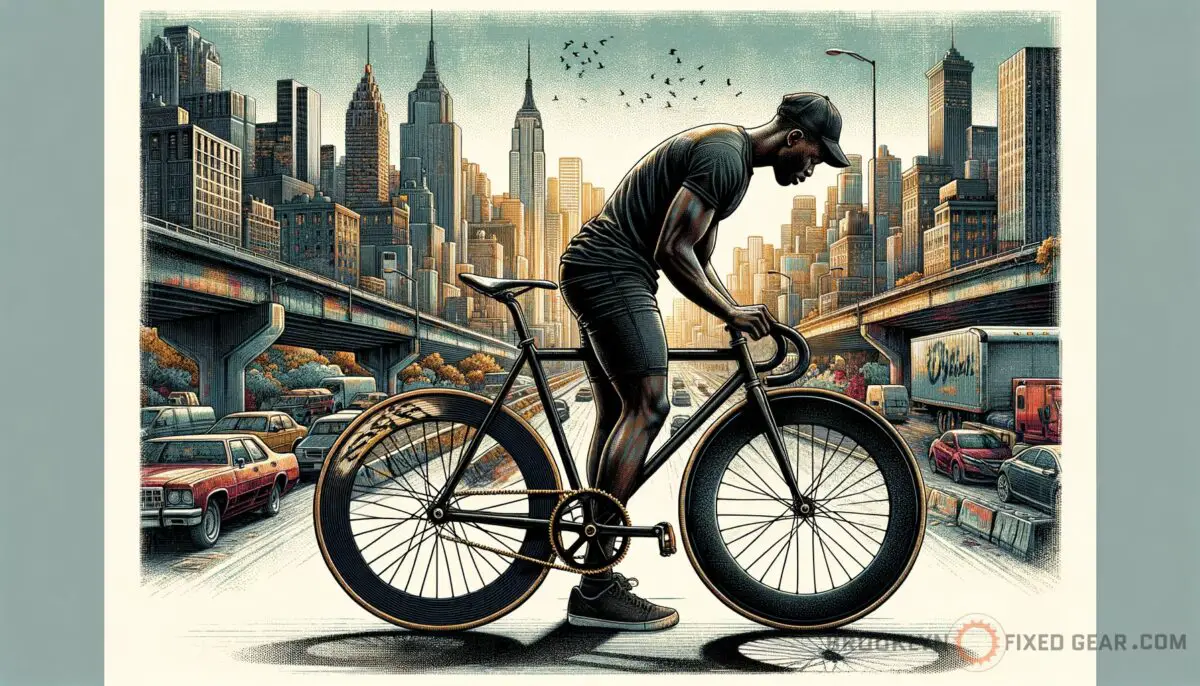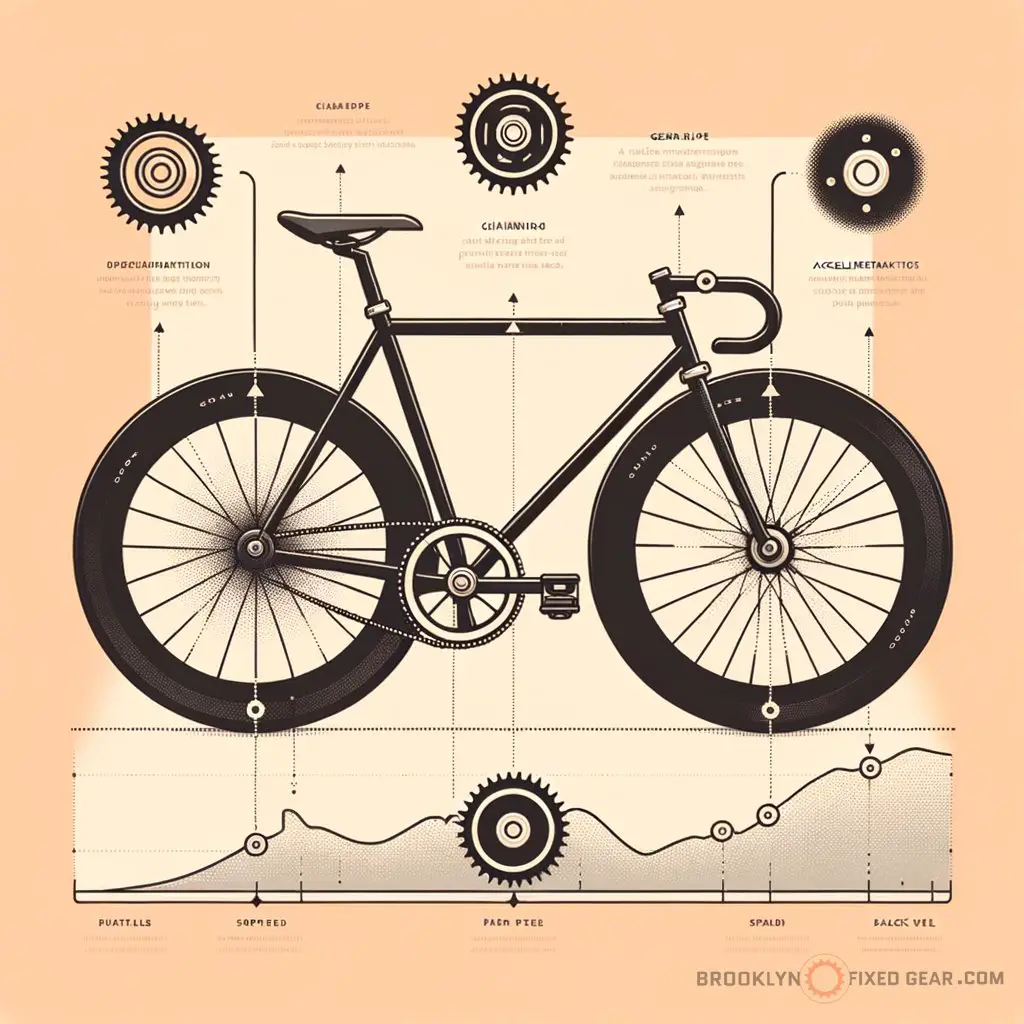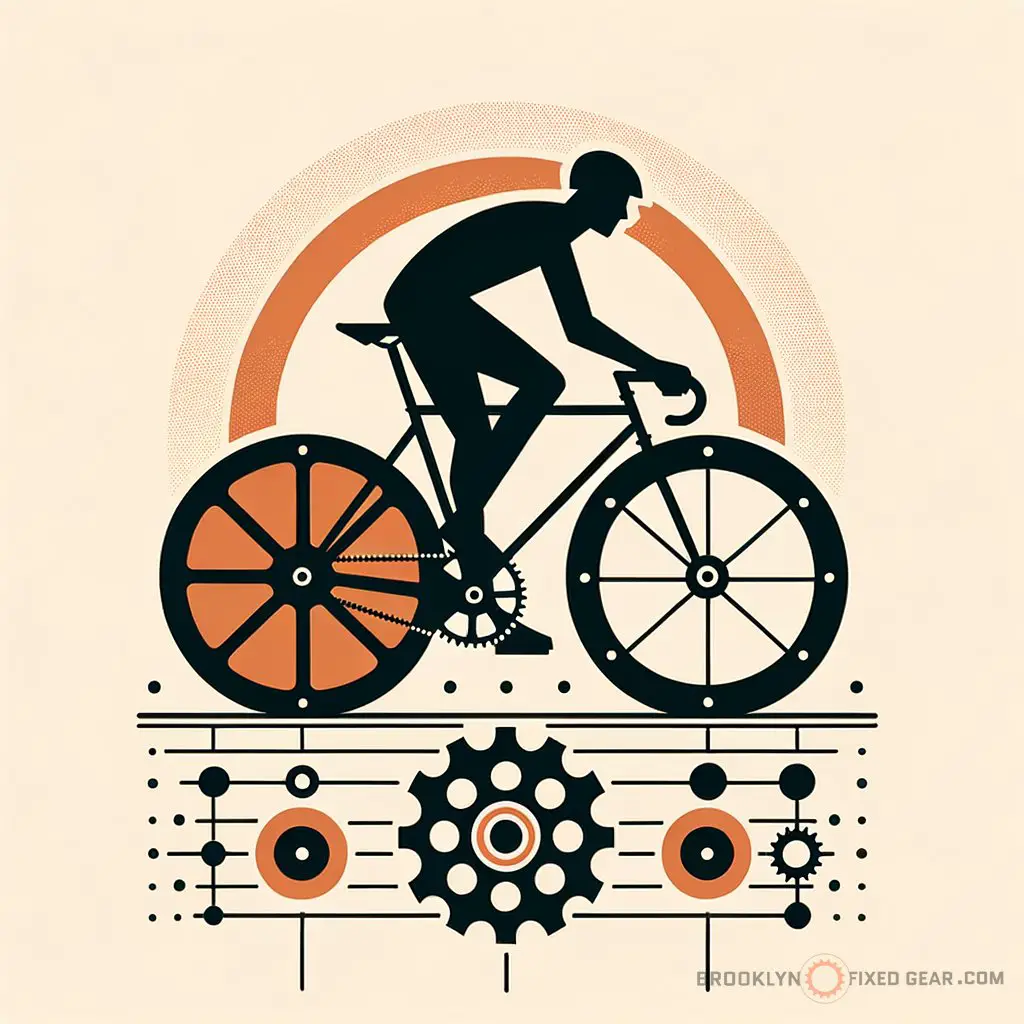Ever zoomed through the bustling streets of New York, dodging taxis and weaving through traffic on a fixie? There’s a unique thrill to mastering the pure connection between rider and road that only a fixed-gear bike offers. But have you ever wondered how tweaking your gear ratios can revolutionize your ride?
In the following sections, we’ll dive deep into fixed-gear bike mechanics and how altering your gear ratios can level up your cycling game.
Key takeaways
- Adjusting gear ratios significantly impacts performance, comfort, and efficiency.
- Choosing the right gear ratio is crucial for injury prevention and joint health.
- Experiment with gear ratios to fine-tune your bike for different cycling conditions.
How gear ratios affect fixed gear bike performance
Exploring the intricate dance between a fixed-gear bike’s performance and its gear ratios is like uncovering a hidden layer of potential beneath your wheels. Gear ratios on fixies are pivotal because they directly influence your pedaling efficiency and your bike’s response to the unique challenges the concrete jungle throws at you.

First off, understand that the gear ratio is the relationship between your chainring size (the big gears by the pedals) and your cog size (the smaller gear on the back wheel). It’s this pairing that dictates how hard you’ll need to pump those legs to maintain speed or conquer that notorious bridge incline. Get it right, and you’ll find a harmony between effort and speed that feels just natural.
A good gear ratio balances the need for acceleration, which is essential when darting through city intersections, and maintaining a steady speed once you’re up to cruising pace. It’s not just about making the ride easier or tougher; it’s about fine-tuning your bike to work with your body’s strengths and the terrain’s demands. Whether you’re sprinting in a street race or tackling a daily commute, the right gear ratio can mean the difference between feeling gassed and getting that glorious second wind.
Here’s why I believe adjusting your gear ratios is key to a sublime cycling experience:
- Tailored performance: Optimize your bike to match your riding style and local terrain.
- Increased efficiency: Find that sweet spot for energy output versus movement.
- Enhanced control: Maintain better handling during high speeds and tight turns.
- Smoother acceleration: Get up to speed quicker with less strain on your legs.
- Strategic training: Adjust ratios for specific workout goals or to increase endurance.
As you tinker with your setup, consider these insights for a ride that feels less like wrestling with your bike and more like a synchronized dance with the asphalt. Read on to discover how to select the best bike multi-tools for adjusting gears and why mindfulness can be just as important as muscle in competitive cycling.
State Bicycle Co. Black Label 6061

State Bicycle Co. Black Label 6061
Understanding gear ratios and their impact on speed
To truly grasp how gear ratios transform a fixie’s performance, think of them as your bike’s transmission. A higher gear ratio, with larger front chainrings or smaller rear cogs, translates to more distance covered per pedal stroke. This means you’ll move faster on flat stretches, but with more effort needed to pedal.
“Switching up gear ratios is like having a new workout at your disposal. A higher ratio can build power in your legs, perfect for short sprints or muscle endurance. Lower ratios can help hone your cadence and cardiovascular health.”
In contrast, a lower gear ratio makes it easier to pedal, especially useful for climbing hills or starting from a stop. You won’t tire as quickly, but your top speed will be lower. It’s a balancing act – gear up for speed, gear down for endurance.
And remember, even the best fixie bikes need the right gear ratio to truly excel.
Fine-tuning gear ratios for city riding
City cycling has its unique set of challenges, and the right gear ratio can make all the difference. A moderate ratio helps you accelerate quickly after stops without leaving you gassed every two streets. It’s about finding that middle ground where you can zip through traffic without overworking your legs.

Don’t forget, safety is key when navigating urban landscapes. An adept gear ratio ensures you’re not compromising control when those unpredictable city moments happen. Jumping curbs or quick dodges; a harmonized bike responds better.
Check out these advanced riding techniques for fixed gear cyclists to really polish your urban moves.
The role of gear ratios in track racing
Track racing is where gear ratios shine. On velodromes, where there are no hills to climb, racers usually opt for higher gear ratios. This allows for a greater top speed, crucial in these high-octane environments.
But be warned – a ratio too high can exhaust you quickly, sabotaging your race.
Here, subtle adjustments to your ratio can be the deciding factor between first place and the rest. Gear ratio isn’t just about raw power; it’s also about rhythm and sustaining effort over each lap. For more on refining your speed, dive into the principles of aerodynamics in cycling efficiency.
Gear ratios and their effects on joint health
Speaking of sustainability, let’s hitch a pause on joint health. A bad gear ratio can put unnecessary strain on your knees and hips, potentially sidelining you with an injury. A ratio that’s too high makes you push harder, which can be tough on the joints, while a ratio too low could lead to a choppy, jarring cycle motion.
Striking the right balance helps you maintain a consistent, fluid cycling motion, reducing the risk of injury. You might find insights from how soon you can start cycling after knee surgery particularly useful when contemplating gear ratio choices during recovery.
Training with different gear ratios
Switching up gear ratios is like having a new workout at your disposal. A higher ratio can build power in your legs, perfect for short sprints or muscle endurance. Lower ratios can help hone your cadence and cardiovascular health, which is essential for longer rides or when you’re looking to improve your stamina.
Therefore, gear ratios are a tool in your cycling training arsenal; leveraging them can lead to significant gains in performance. You’ll want the best gear on hand for that, so don’t miss out on the best bike multi-tools for those quick adjustments.
Choosing the right gear ratio for endurance rides
We’ve touched on power and speed, but let’s chat endurance. Whether you’re tackling a century ride or just looking to enjoy a full day out, the right gear ratio can ease the strain. You’ll want a ratio that allows for a comfortable pedal stroke without overexerting yourself over those lengthy miles.
Consider also complementing your endurance strategy with exercise plans from cross-training effects on cycling, to maximize your overall biking prowess.
Environmental considerations and gear ratios
As a conscientious rider, you’ll appreciate the link between cycling and sustainability. The efficiency gained from a well-choiced gear ratio means less energy spent and a smaller carbon footprint for those focused on environmentally friendly travel. Get more insights on cycling’s eco-benefits from sustainability and cycling benefits.
Using gear ratios to conquer varied terrains
No two rides are ever the same, and that’s where the versatility of your gear ratio comes in. If you’re switching between city streets and riverside paths, a quick ratio tweak can adapt your ride for better control and efficiency, no matter the terrain.
If you’ve previously shunned changing ratios due to the hassle, learning common mistakes made when building a fixie might just show you how straightforward and impactful it can be.
Gear ratios impact on cycling culture
Gear ratios go beyond mechanics; they’re a culture within the cycling community. It’s a nod to those who know their ratios and how to use them. Swapping gear ratio stories and advice is part of the fixie fellowship.
For a piece of cycling culture history, check out how the movie ‘Quicksilver’ made Kevin Bacon an urban cycling hero, and see how gear talk has always been part of our world.
Choosing the perfect gear ratio is not a one-time setup. It’s an ongoing, dynamic process that evolves with your riding style, fitness level, and cycling goals. Play with it, master it, and you’ll unlock the full potential of your fixie that’s waiting right beneath you.
For those moments when you need peak performance, don’t leave it to chance. Make sure your saddle is on point too by discovering how to choose a bike saddle that matches your commitment to precision.
Sample Gear Ratio Comparison Data
| Gear Ratio | Typical Use Case | Acceleration | Top Speed | Effort Required |
|---|---|---|---|---|
| 2.75 (44:16) | Urban commuting | Fast | Moderate | Moderate |
| 3.0 (48:16) | Aggressive urban riding | Moderate | Fast | High |
| 3.5 (52:15) | Track racing | Slow | Very Fast | Very High |
| 2.5 (40:16) | Casual riding | Very Fast | Slow | Low |
This data table reveals how different gear ratios perform across various fixed-gear cycling scenarios. It highlights the trade-off between acceleration, top speed, and the effort required to maintain these elements across differing ratios.
Perfect ratios for specific riding styles.
When it comes to fixed-gear cycling, the devil is in the details. Gear ratios are no exception—it’s all about precision and understanding what works for your unique riding needs. Below, we’ve compiled a table of dos and don’ts that will help you avoid common missteps and keep your ride smooth and efficient.
| Do This | Don’t Do This |
|---|---|
| Do experiment with different gear ratios to find what feels right. | Don’t stick with a gear ratio that causes discomfort or pain. |
| Do use a lower gear ratio if you’re recovering from an injury. | Don’t choose a high gear ratio without the physical conditioning to handle it. |
| Do consider your local terrain when selecting a gear ratio. | Don’t ignore signs of wear on your chain or cogs—replace as needed. |
| Do carry a multi-tool for on-the-go adjustments. | Don’t neglect the importance of proper chain tension. |
| Do match your gear ratio to your cycling goals, be it speed or endurance. | Don’t overlook the benefits of mindfulness in cycling when selecting gear ratios. |
Essential tips for maintaining an optimal fixed-gear bike setup.
As someone who lives and breathes fixed-gear cycling, I’ve found that gear ratios are like a secret language spoken among those in the know. Picking the right one feels like finding the perfect pitch in a tune—when it’s right, you just know it. Yet this is just my opinion, not carved in stone; every rider has their unique spin on it.
But without a doubt, when you hit that gear ratio sweet spot, your ride transforms. It’s less about fighting the machine and more about becoming one with it. If you’re exploring this world, take a moment to learn from the experiences shared on the impact of urban infrastructure on fixed-gear cycling; every bit helps in crafting your perfect ride.
If you are a visual learner, check out this video titled ‘How to Choose the Fixed/Singlespeed Gearing Best for YOU | Fixed Gear Gearing Guide’
Frequently asked questions (FAQ)
What happens if I choose a gear ratio that’s too high for my riding style?
Choosing a gear ratio that’s too high for your style or fitness level can lead to increased fatigue and may even cause injury due to the strain it puts on your muscles and joints. It’s crucial to select a ratio that allows for a comfortable ride while still meeting your performance needs.
Can the right gear ratio help with long-distance fixed-gear cycling?
Absolutely, the correct gear ratio can make a significant difference in long-distance rides on a fixed-gear bike. It should minimize fatigue by aligning with your natural pedaling cadence and energy output, allowing for a more sustainable riding experience over extended distances.
How usually should I reassess my preferred gear ratio?
It’s wise to reassess your gear ratio whenever you experience a change in riding conditions, personal fitness, or cycling goals. As you grow stronger or if your regular routes change, you might find that your gear ratio needs to evolve to keep up with your development as a cyclist.
Final thoughts
Navigating the world of fixed-gear bikes can be as complex as it is exhilarating. Gear ratios play a fundamental role in tailoring your cycling experience to your needs. Whether you’re tearing up the track, cruising through the city, or embarking on a cross-country journey, a suitable gear ratio can make all the difference.
Tinker, test, and tune to find your perfect match and enjoy the ride your way.
How has fiddling with your gear ratio changed your riding experience? Did I cover everything you wanted to know? Let me know in the comments section below.I read and reply to every comment. If you found this article helpful, share it with a friend, and check out my full blog for more tips and tricks on gear ratios and fixed-gear performance. Thanks for reading and keep spinning those wheels!
















